ving做状语
ving做定语和状语的用法

Answer key for Exercise 2.
approached, Jordan, cheek, curiously, dashed, misunderstood, contrary
Answer key for Exercise 3.
crossroads, adult, major, dormitory, greeted, representing, association, spoken, Colombia, curious, flight
2. The glass doors have taken the place of
the wooden ones at the entrance, ___ in
the natural light during the day. (天
津2007)
A. to let B. letting
C. let
人教课标版 高一 必修4
Unit 4
Grammar
Discovering useful words and expressions: Answer key for Exercise 1.
defence, likely, Italy, canteen, represent, dash, approach, association, cheek, flight
2. The person who is translating the songs can speak seven languages. The person _tr_a_n_s_l_a_ti_n_g_t_h_e _so_n__g_s can speak seven languages.
3. The boy standing there is reading a book about body language. The boy _w_h_o_ _is_ _s_t_a_n_d_in_g_ there is reading a book about body language.
ving做定语和状语

定语
非谓语动词 doing 表示:主动的或正在进行的动作 过去分词(done) 表示:被动的或完成的动作 to do 表示:目的或将来的动作
动词--ing形式作定语和状语
I.v-ing 形式作定语,相当于形容词 前置定语: ving(一个单词)+n 后置定语: n+ ving短语(大于一个单词) 1.表示正在进行 a listening child= a child who is listening 2.表示功能用途 a walking stick= a stick for walking. 3.表示性质 an interesting book
5) 表条件
If you use your head, you will find a way.
=Using your head, you will find a way. 一直往前走, 你就会看到一座白色地房子。 ______________, Walking ahead you will see a white house.
单句改错
1. Having not seen the film, I can’t tell you what I think of it. Not having 2. The men worked for extra hours got an extra pay. working 3. Seen from the top of the hill, we find the city more beautiful. Seeing 4. Generally speak, facial expressions are helpful communications, too. speaking
Ving作状语

表示动作的结果
Ving作状语可以表示动作的自然结果 Ving作状语可以表示动作的预期结果 Ving作状语可以表示动作的意外结果 Ving作状语可以表示动作的伴随结果
与-ing分词短语的区别
结构不同:-ing分词短语是独立的结构,而Ving作状语是作为状语存在的。
意思不同:-ing分词短语通常表示正在进行的动作或状态,而Ving作状语可以表示 时间、条件、让步等关系。
Ving作状语可以表示伴随的动作,如“He walked along the river,singing l o u d l y. ”
Ving作状语可以表示结果,如“I tried to open the door,only to find it locked.”
表示动作的伴随情况
Ving作状语可以表示主语执行的动作的同时伴随其他动作的发生 Ving作状语可以用来描述主语在执行主要动作时伴随的状态或条件 Ving作状语可以用来强调主语执行的动作与伴随动作之间的关联性 Ving作状语可以用来补充说明主语执行的动作时伴随的其他情况
书面语与口语的区 分
正式与非正式场合 的区分
特定语境场合的区 分
不同领域和专业领 域的区分
注意与其它成分的搭配
注意与主语的搭配:Ving作状语时,应与主语保持逻辑一致,避免产生歧义。 注意与谓语的搭配:Ving作状语时,应与谓语保持时态和语态的一致,以避免语法错误。 注意与宾语的搭配:Ving作状语时,应与宾语保持逻辑一致,确保句子的意思清晰明确。 注意与其它状语的搭配:Ving作状语时,应与其他状语保持合理的顺序,以使句子更加通顺。
汇报人:XX
添加标题
添加标题
添加标题
添加标题
语义关系不同:Ving作状语与独立 主格结构在语义关系上存在差异。
v-ing作状语 经典课件

3). Walking in the street, I saw a tailor’s shop. 时间
When I was walking in the street.
4). Her husband died, leaving her 3 kids to look after.
结果
…and left her 3 kids to look after.
1. Being poor, he couldn’t afford a TV set. 2. Being ill, he didn’t go to school. 3. Being poor, the old man was happy. Tip 4: be - being
4. Not knowing her address, we can’t get in touch with her. Tip 5: 否定在Ving前加not
Grammar Ving as Adverbial —动词ing做状语
Read the sentences and try to feel.
1.When I was walking in the street, I came across an old friend of mine. Walking in the street, I came across an old friend of mine.
ving作状语的四种形式一般式进行被动beingdonehavingdonehavingbeendoneving动作与谓语同时发生主语一致且为主动ving动作正在进行且与主语成被动关系ving先于谓语动作完成且造成影响主动ving先于谓语动作发生且为被动有影响相当于过去分词iii
Module 2 Fantasy Literature
五动名词现在分词过去分词Ving结构
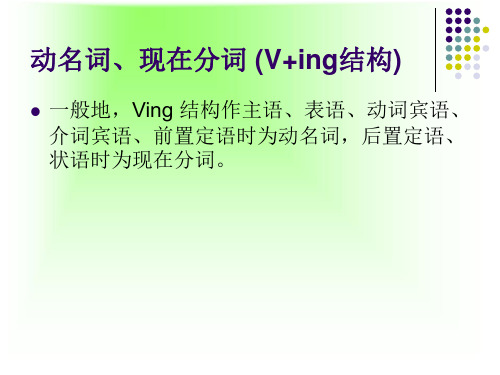
attempt, begin, continue, forget, remember, hate, learn, like, love, prefer, need, regret, start, stop, try, want
作主语 Learning without practice is no good. 作主语时有时用it引导的形式主语。 It is no good learning without practice. It is worthwhile discussing the question again.
动名词、现在分词 (V+ing结构)
一般地,Ving 结构作主语、表语、动词宾语、 介词宾语、前置定语时为动名词,后置定语、 状语时为现在分词。
动名词、现在分词 (V+ing结构)
动名词:既具有动词的性质,后可接宾语,可 用副词修饰语,又占据名词的位置,可作主语、 动词宾语、介词宾语和补语。
动名词、现在分词 (V+ing结构)一
They began studying computer last week.
动名词、现在分词 (V+ing结构)四
1. remember, forget, regret Can’t you remember telling me the story last night? You must remember to tell him the news. I don’t regret telling her what I thought. 2. need, want The letter needs signing. =The letter needs to be
ving的用法

被动形式
一般 式 完成 式
doing having done
being done
having been done
ving的被动式
• He hates being interrupted. • 他不愿意被人打断。 • I’m not used to being treated like this. • 我不习惯受这种款待。 • I appreciate being given this opportunity. • 我很感谢给了我这个机会。
exercises
• 1.(2008江苏卷)--- They are quiet, aren’t they? • --- Yes. They are accustomed ____________ at meals. • A. to talk • B. to not talk • C. to talking • D. to not talking
ving的完成式
• • • • • He denied having been there. 他不承认到过那里。 She admits having seen us. 她承认见到了我们。 The safe showed no sign of having been touched. • 保险柜没有被人动过的痕迹。
• a swimming pool • a dancing hall
• • • • •
a smoking room a sleeping bag a writing desk writing paper drinking water
• 1)结论:动名词作定语用来说 明该名词的用途,不表示名词 本身的动作。(作前置定语)
• 1.动词ing 作状语,其否定形式 为 在它前面加not,never等。 • Not knowing how to find the station, I asked a policeman for help.
(完整版)人教版Book6 Unit5 语法--ving作状语导学案设计
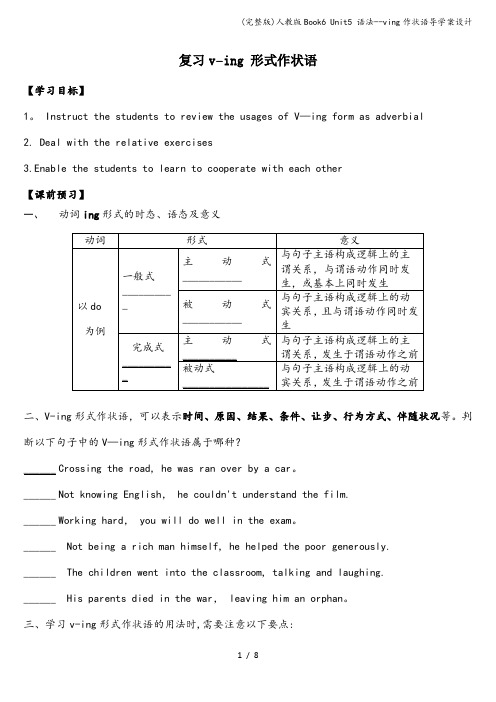
复习v–ing 形式作状语【学习目标】1。
Instruct the students to review the usages of V—ing form as adverbial2. Deal with the relative exercises3.Enable the students to learn to cooperate with each other【课前预习】一、动词ing形式的时态、语态及意义二、V-ing形式作状语,可以表示时间、原因、结果、条件、让步、行为方式、伴随状况等。
判断以下句子中的V—ing形式作状语属于哪种?______ Crossing the road, he was ran over by a car。
______ Not knowing English, he couldn't understand the film.______ Working hard, you will do well in the exam。
______ Not being a rich man himself, he helped the poor generously.______ The children went into the classroom, talking and laughing.______ His parents died in the war, leaving him an orphan。
三、学习v-ing形式作状语的用法时,需要注意以下要点:1)与过去分词作状语的区别: 一般来说,v-ing形式表示____________; 过去分词表示被动、完成。
The enemy fled in a panic, leaving behind a lot of dead bodies and weapons.Defeated and frightened, the enemy fled in a panic.2)分词(短语)作状语时,其逻辑主语必须与句子的主语_______.如果不一致,必须用独立主格结构来表示,也就是在分词前加上它的_______________。
ving作状语
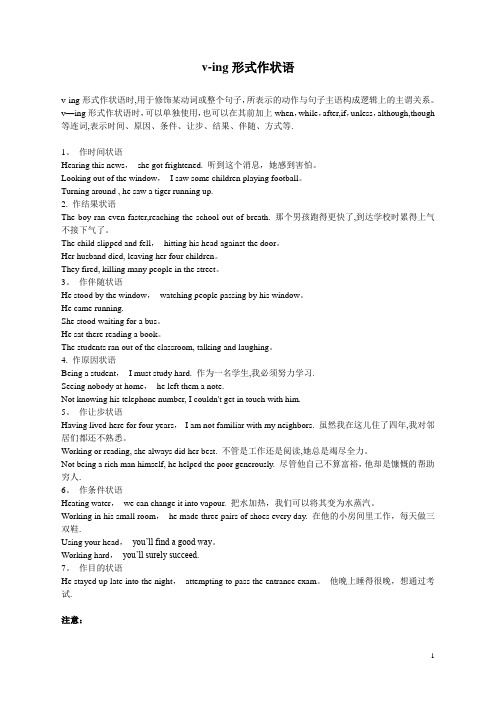
v-ing形式作状语v-ing形式作状语时,用于修饰某动词或整个句子,所表示的动作与句子主语构成逻辑上的主谓关系。
v—ing形式作状语时,可以单独使用,也可以在其前加上when,while,after,if,unless,although,though 等连词,表示时间、原因、条件、让步、结果、伴随、方式等.1。
作时间状语Hearing this news,she got frightened. 听到这个消息,她感到害怕。
Looking out of the window,I saw some children playing football。
Turning around , he saw a tiger running up.2. 作结果状语The boy ran even faster,reaching the school out of breath. 那个男孩跑得更快了,到达学校时累得上气不接下气了。
The child slipped and fell,hitting his head against the door。
Her husband died, leaving her four children。
They fired, killing many people in the street。
3。
作伴随状语He stood by the window,watching people passing by his window。
He came running.She stood waiting for a bus。
He sat there reading a book。
The students ran out of the classroom, talking and laughing。
4. 作原因状语Being a student,I must study hard. 作为一名学生,我必须努力学习.Seeing nobody at home,he left them a note.Not knowing his telephone number, I couldn't get in touch with him.5。
ving的用法解读
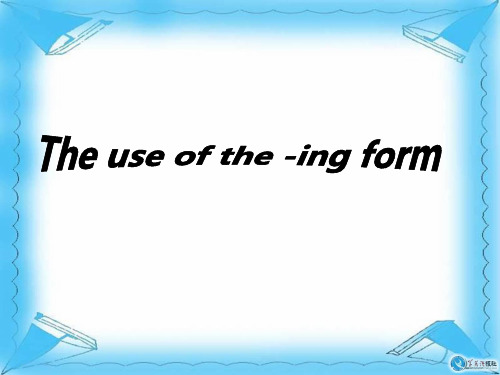
例句
• • • • 1. Avoid over-eating. 2.He admitted taking the money. 3.I can’t help laughing. 4.I finished reading the book last night.
②既可接动名词又可接不定式作 宾语的动词,常见的有:begin, start,continue,intend,like, love,prefer,mean,forget, regret, remember,hate ,go on, stop 等。
我真后悔没赶上那次报告会。 I regret missing the report. 我遗憾地告诉你我不能接受你的建 议。 I regret to say I can’t take your advice.
D在try,mean之后意义各不相同, try to do (设法), try doing (试试), mean to do (打算,有意要做) mean doing (意思是,意味着)。如:
• a book explaining how to cut the death rate • Following jane’s way of studying chimps, our group are going to visit the动形式
比较下列三组句子
• 我记得我已把信寄了。 • I remember posting the letter. • 我会记着去寄信的。 • I’ll remember to post the letter.
我永远不会忘记见到过那位著名 作家。 I shall never forget seeing the famous writer. 不要忘了给你母亲写信。 Don’t forget to write to your mother.
Ving作主宾表定状补

A. 在 like, love, hate, prefer之后, 用-ing或to do意思一样,不过-ing表泛指 to do表具体、一次性动作 B. 在 begin/start, continue之后, 用-ing或to do意思一样 C. 在动词forget, remember, regret之后, 动名词表示动作做了, 不定式表示没做
Walking ________(walk)is a good form of exercise for both young and old.
Watching _________(watch)news on TV has become a routine for me.
教育孩子需要耐心。 Teaching children needs patience.
其他补充: 其他补充: go on/carry on/stop doing停/继续正在做的 go on/carry on/stop to do 停/继续转另一事 mean/try to do 打算/努力去做 mean/try doing 意味着/尝试 be used to doing (介词)适应于 be used to do (被动)被用作.. can’t help doing 情不自禁 can’t help to do 不能帮助
— Let me tell you something about the journalists. B — Don’t you remember ________ me the story yesterday? A. told B. telling C. to tell D. to have told
Grammar
The –ing form as the Subject and Object
Ving作状语的解题技巧
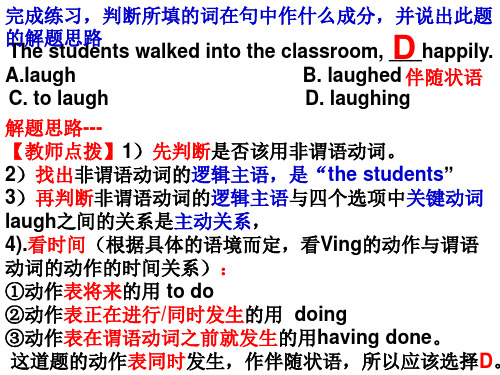
_ __ __
____
_______ __ ___________________
ing作结果状语时,一般用doing的一般式,其逻辑 主语是一件事(即:前面的整个句子)
Eg: 1. ____________making him end up in He robbed the bank, prison. 2.______________ winning the final Their team worked hard, game. 配套练习: Some factories pour their waste chemicals C into the river, ______the river and the fish . A. to kill B. killed C. killing D. having killed
配套练习:做综合练习2、4题 2.C 4. D 第四步:判断Ving的动作与谓语动词的时间关系 任务:比较下列句子,注意划线部分,判断ving与 谓语动词的时间关系。 1. He stood there waiting for his mother. 2. Having waited for two hours, he went away. 方法: doing/being done ①动作表正在进行/与谓语动词同时发生的用___________ ②动作表在谓语动词之前就发生的用_____________ having done/having been done ③动作表将来的用 to do/to be done
读下列句子,找出-ing的逻辑主语 1. Opening the door, I found nobody in. 2. Being poor, they couldn’t afford to buy a house. 3. Working hard, you’ll succeed. 4. Weighing 100 kilograms, the stone was moved by him alone. 5. The other people sat in the chair and acted out the story using sign language. 6. They sat there, smiling. 7. His parents were killed in the earthquake , leaving him an orphan. 教师点拨:
动词Ving的用法
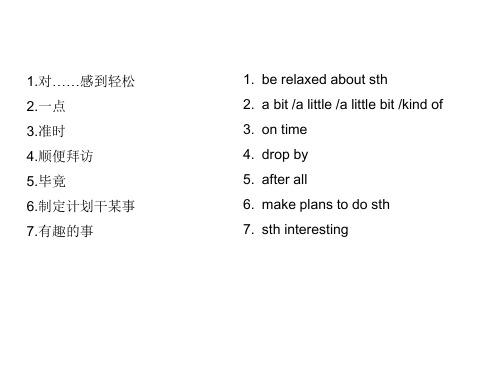
4.作状语表示伴随状况 1).The children went to the park, laughing on the way. 2).She lies on the bed, holding one of her toy animals. 3).You look at me and I look at you, both knowing. 4).She entered the room, smiling from ear to ear. 5).He said to himself, putting all the money in his pocket. 5.作状语表示原因 Feeling tried, I went to bed early. Being ill, he didn’t come to school today.
6.制定计划干某事
7.有趣的事
V-ing 是动词的一种非谓语形式,不能单独作谓语,与不定式 一样, V-ing也可以带有自己的宾语或状语,构成V-ing短语。 1.作主语 Talking is easier than doing. Going to college is my dream. Spending time with your family and your friends is very important. 2.作宾语 I practice speaking English every day. I have already finished doing my homework. He’s looking forword to seeing you. Thank you for helping me. 3.作宾补 Suddenly I saw a woman lying on the ground. I kept the fire burning all day and all night.
V-ing 作状语
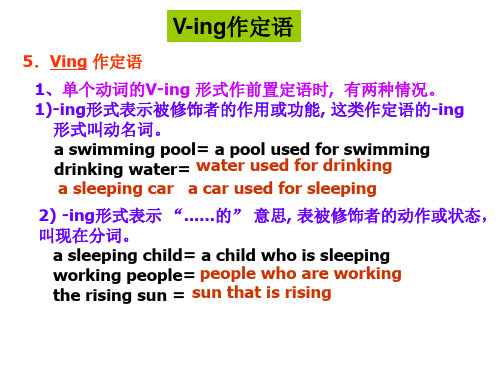
2.V-ing形式与句子主语之间的主动与被动关系. 当V-ing形式与句子主语之间存在逻辑上的主谓关系 时,用主动式 。 当V-ing形式与句子主语之间存在逻辑上的动宾关系 时,用被动式 。 Not receiving any letter from him, I gave him a call. 由于没有收到他的信,我给他打了个电话。(逻辑上 的主谓关系) Having being told many times, he still couldn’t understand it. 多次被告知后,他还是不懂。 (Having being told…与句子主语之间存在逻辑上 的动宾关系,并表示动作在前。)
Having finished their work,they had a rest. (相当于时间状语从句) After they finished their work,they had a rest.
二、形式与基本句型
1.V-ing形式有下列形式变化.
主动式 一般式为 v-ing 完成式为having v-ed
3) 表方式、伴随状语可转换成并列句
He sat on the sofa, watching TV. (=He sat on the sofa, and watched TV.)
他斜靠(lean)着墙站着。 He stood leaning against the wall. (=He stood and leaned against the wall.)
时间关系当ving形式所表示的动作与主句谓语动词所表示的动作同时或几乎同时发生时用一般式
V-ing作定语
5.Ving 作定语 1、单个动词的V-ing 形式作前置定语时, 有两种情况。 1)-ing形式表示被修饰者的作用或功能, 这类作定语的-ing 形式叫动名词。 a swimming pool= a pool used for swimming drinking water= water used for drinking a sleeping car a car used for sleeping
- 1、下载文档前请自行甄别文档内容的完整性,平台不提供额外的编辑、内容补充、找答案等附加服务。
- 2、"仅部分预览"的文档,不可在线预览部分如存在完整性等问题,可反馈申请退款(可完整预览的文档不适用该条件!)。
- 3、如文档侵犯您的权益,请联系客服反馈,我们会尽快为您处理(人工客服工作时间:9:00-18:30)。
动词的-ing形式作状语
【观察】观察下列句子中动词的-ing形式作状语的用法,然后加以总结。
1. Arriving at the classroom, the children began to do cleaning.
2. She doesn’t feel like eating anything, being ill for a few days.
3. Working hard, you will succeed sooner or later.
4. Weighing almost one hundred kilos, the stone was moved by him alone.
5. The song is sung all over the country, making it very popular.
6. Travelling by car, we visited many exciting and beautiful places.
7. While/When reading the book, he nodded from time to time.
8. Make sure to read all choices before deciding on the best answer.
9. After finishing reading the letter, he went on to write a reply.
10. On/Upon hearing their teacher’s voice, the pupils stopped talking at once.
11. The car was caught in a traffic jam, thus causing the delay.
12. Though/Although raining heavily, it cleared up very soon.
13. I have accepted this, not wanting to disappoint them.
14. Generally speaking, people like to hear compliments from others.
【总结】
Ⅰ. 动词的-ing形式作状语的用法
动词的-ing形式作状语,通常表示主语正在进行的另一动作,用来对谓语动词表示的动作加以修饰或作为陪衬。
它可表示时间、条件、原因、让步、结果、方式或伴随动作,相当于相应的状语从句。
◆作时间状语,多置于句首,也可置于句末。
(如例句1)
◆作原因状语,多置于句首或句末,也可置于句中。
(如例句2)
◆作条件状语,多置于句首。
(如例句3)
◆作让步状语,多置于句首。
(如例句4)
◆作结果状语,多置于句末。
(如例句5)
◆作方式或伴随状语,多置于句末,也可置于句首。
(如例句6)
【区别】动词的-ing形式和动词不定式作结果状语:
动词的-ing形式表示“正常出现的、自然而然的或意料之中的”结果。
通常位于句末,其前有逗号隔开。
有时为了强调,可在现在分词前加副词thus, therefore 等。
动词不定式表示意料之外的结果。
尤其是和only连用。
如:
She ran to the station, only to find that the train had left.
【特别提醒】为强调-ing形式所表达的意义,在-ing形式短语前可用连词、介词或副词。
◆“when/while+-ing形式”强调-ing形式与谓语动词的动作同时发生。
(如例句7)◆“befor e + -ing形式”强调-ing形式在谓语动词所表示的动作之后发生。
(如例句8)
◆“after+动词的-ing形式”强调-ing形式在谓语动词所表示的动作之前发生。
(如例句9)
◆“on/upon + -ing形式”表示“一(刚)……就……”。
(如例句10)
◆“thus + -ing形式”表示结果。
(如例句11)
◆“though /although+ -ing形式”表示让步。
(如例句12)
Ⅱ. 动词的-ing形式的否定形式动词的-ing形式的否定形式为“not+-ing形
式”。
(如例句13)【难点点拨】动词的-ing形式作状语应该注意的问题:
◆现在分词作状语时,其逻辑主语必须与句子的主语一致,且为主动关系。
◆独立成分作状语。
常见的有:generally speaking一般地说;strictly speaking 严格地说;frankly speaking 坦率地说;exactly speaking 确切地说;judging from/by 由……判断出。
(如例句14)
语法巩固练习句型转换。
(每空一词)
1. I stood by the door, and did not dare to say a word.
→I stood by the door, ____ ______to say a word.
2. I could not but laugh as soon as I saw such a funny sight.
→I could not but laugh _____ ______such a funny sight.
3. While he was working in the factory, he was an advanced worker.
→ in the factory, he was an advanced worker.
→ in the factory, he was an advanced worker.
4. Because I didn’t know his telephone number, I couldn’t ring him.
→ his telephone number, I couldn’t ring him.
5. Look on the bright side of things, and you will live happily.
→ on the bright side of things, you will live happily.
→ on the bright side of things, you will live happily.
6. Before you leave the classroom, please turn off the lights.
→ the classroom, please turn off the lig hts.
7. He worked day and night, and as a result it made himself near-sighted.
→He worked day and night, himself near-sighted.
→He worked day and night, himself near-sighted.
8. The three young girls stood under the tree, and they laughed and talked merrily.
→The three you ng girls stood under the tree, and merrily.
Keys: 1. not daring 2. on/upon seeing 3. Working; While working 4. Not knowing
5. If you look; Looking
6. Before leaving
7. making; thus making
8. laughing; talking。
